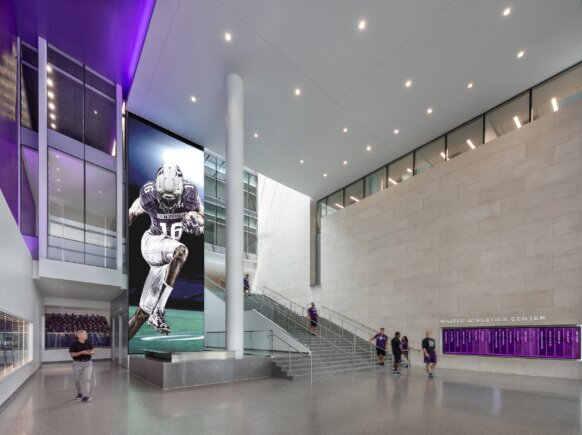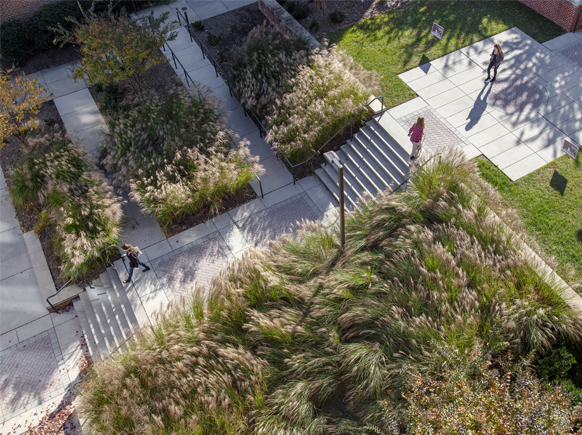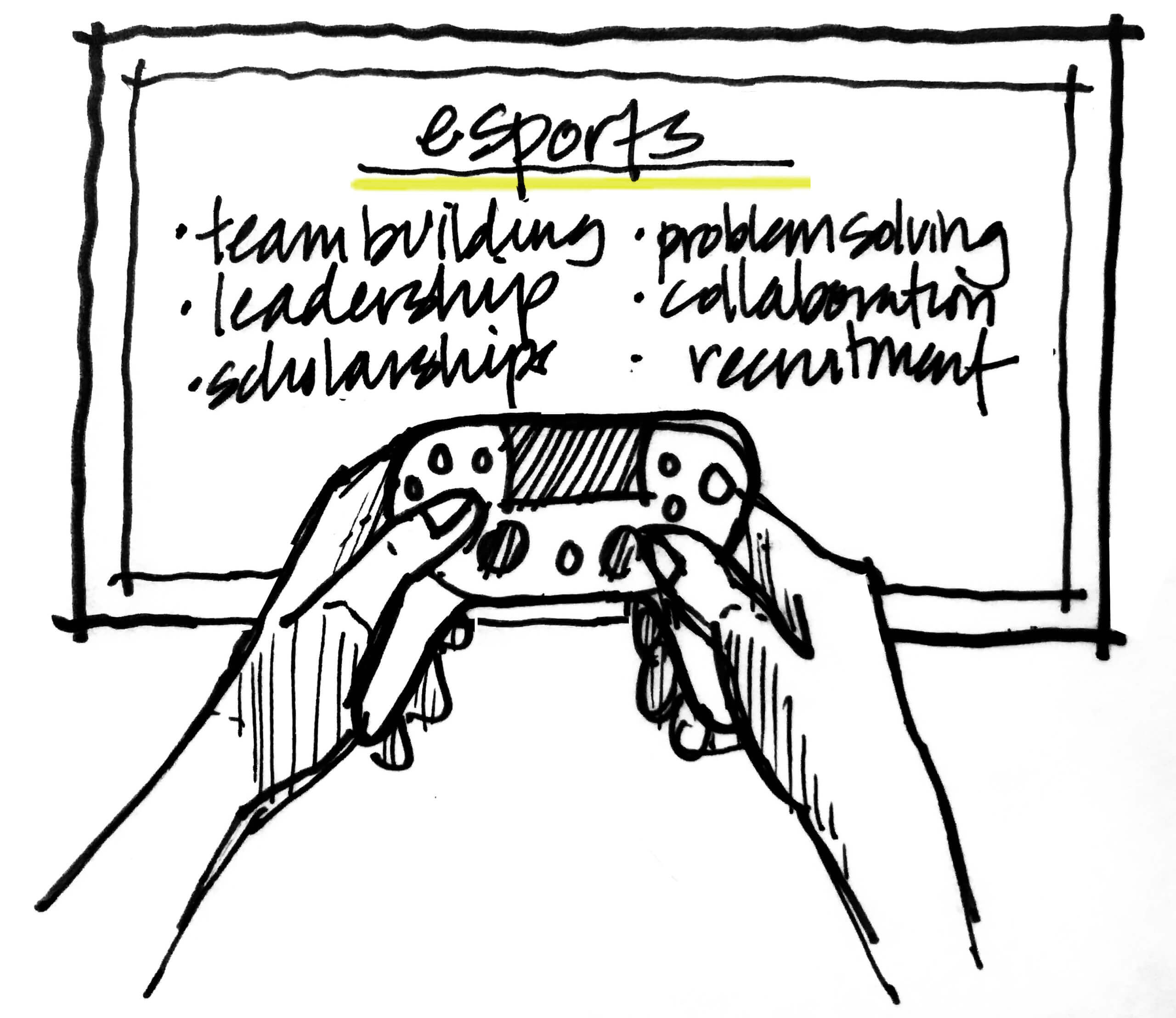
As the world, including the sporting world, was upended by the COVID-19 pandemic, one sector has proven thoroughly resilient: esports, or competitive video gaming, where players can participate remotely and spectators can watch matches from home. According to Verizon CEO Hans Vestberg, gaming was up 75 percent during the beginning of the shutdown. By 2021, analysts project that esports will have 84 million viewers, which will exceed every other professional sports league except the NFL.
Pre-pandemic, esports had become a staple in high schools and universities. The High School Esports League has grown to include more than 3,000 schools and 80,000 students. Universities and colleges seeking to improve their esports programs offer scholarships to recruit top players from high school. Ashland University was the first school to offer scholarships in 2018 at $4,000 for competitive gaming. Today, Robert Morris University offers a $76,000 scholarship over four years.
Many universities are also building out official esports programs. Ohio State University launched a comprehensive gaming program with high-end facilities, academic degrees, and elective courses in the subject. And Full Sail University built “The Fortress,” a new $6 million esports arena that can accommodate 100 esports athletes and more than 500 live spectators simultaneously.
Esports’ rise pre-pandemic and now
One theory behind the rapid growth? Esports, and their facilities, are inherently inclusive. Because one’s physical ability does not impact participation, there’s an opportunity for marginalized students with disabilities to be equal; everyone has the same chance to practice problem-solving, team building, and leadership—skills that are crucial to post-secondary success. Practice facilities provide ADA-compliant, ergonomic, flexible gaming areas, where students with disabilities can game comfortably. Facilities also include viewing areas where students with disabilities can watch the performance and interact with others without physical obstacles.
Prior to the pandemic, K-12 school districts accommodated esports with modest training rooms, as opposed to the professional level gaming spaces and hardware more typical of universities. Schools would often rehab existing areas to support gamer training, holding competitions in larger spaces such as theaters, gyms, or cafeterias. However, arenas weren’t unheard of for high schools pre-COVID. In December of 2019, Burlington Public School in Massachusetts announced the building of AREA 123, a new esports arena. And Lebanon High School in Pennsylvania held a ribbon-cutting ceremony for its new esports arena in March, right before the pandemic.
Just as esports in schools was booming, nearly all students in the United States have adapted to distance or hybrid learning over the past six months—and many will continue to learn remotely for the foreseeable future. But while K-12 sports’ seasons were widely canceled, esports teams continue to grow and compete—perhaps thriving more so in light of in-person sports being off the menu. Now, school districts face questions surrounding how to support growing interest in these programs when it’s safe for students to return full-time. Architects who have been at the forefront of designing esports arenas and practice spaces will now have to shift design concepts to accommodate both increased participation and public health guidelines.
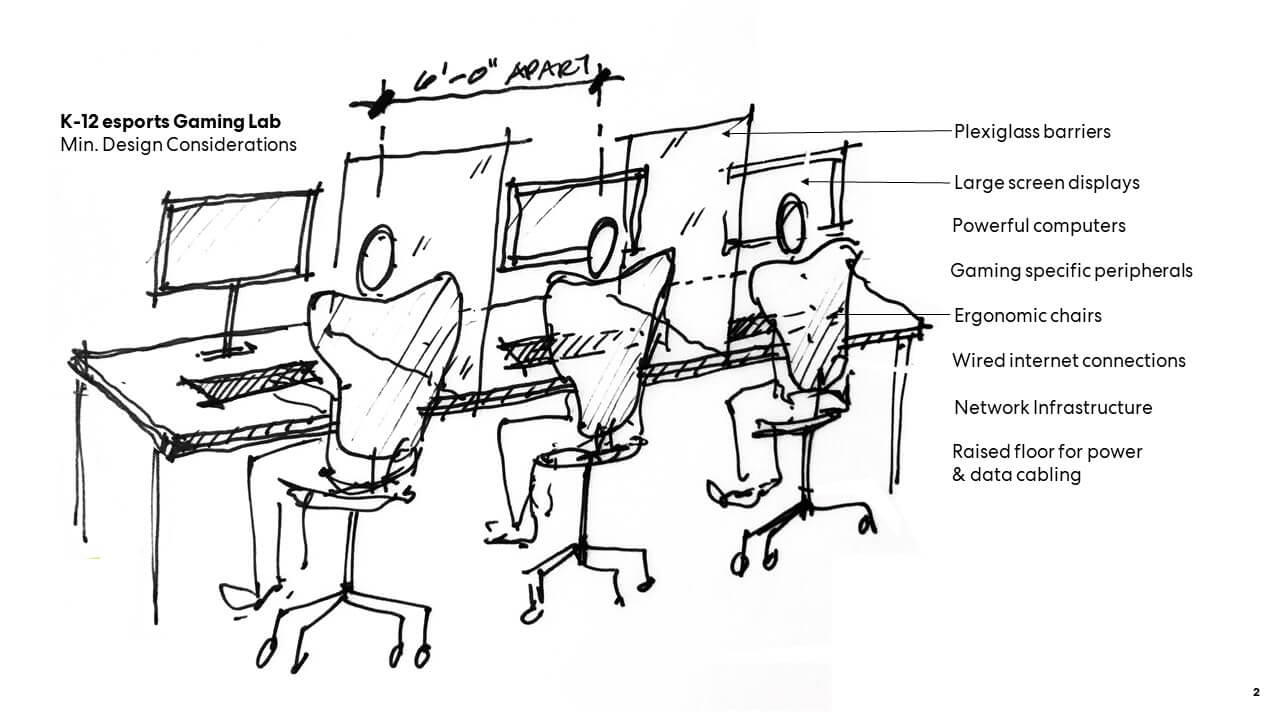
Best Practices for Esports Spaces Now—and Beyond
As we re-imagine what esports will look like when students return to school, we have a unique challenge and opportunity: to design for the continued growth of gaming while adhering to strict safety and health standards. Guided by our research, along with recommended safety configurations by esports leaders, we recommend the following approaches.
Esports Gaming Lab
At a minimum, esports participants need a practice space outfitted with basic equipment that allows them to compete on a level playing field with participants from other schools. This includes powerful computers, wired internet connections, network infrastructure, gaming-specific peripherals (headset, mouse, keypad), upgraded graphics cards, large screen displays, ergonomic furniture, and a shoutcasting booth, or soundproof space for announcing game highlights. K-12 esports spaces can start small and grow as their program increases. The space could resemble a lounge and be as small as a typical 900 square foot classroom with stations spaced at least 6 feet apart and separated by plexiglass barriers to ensure social distancing. A custom-designed raised floor can hide power and data cabling and keep stations tidy.
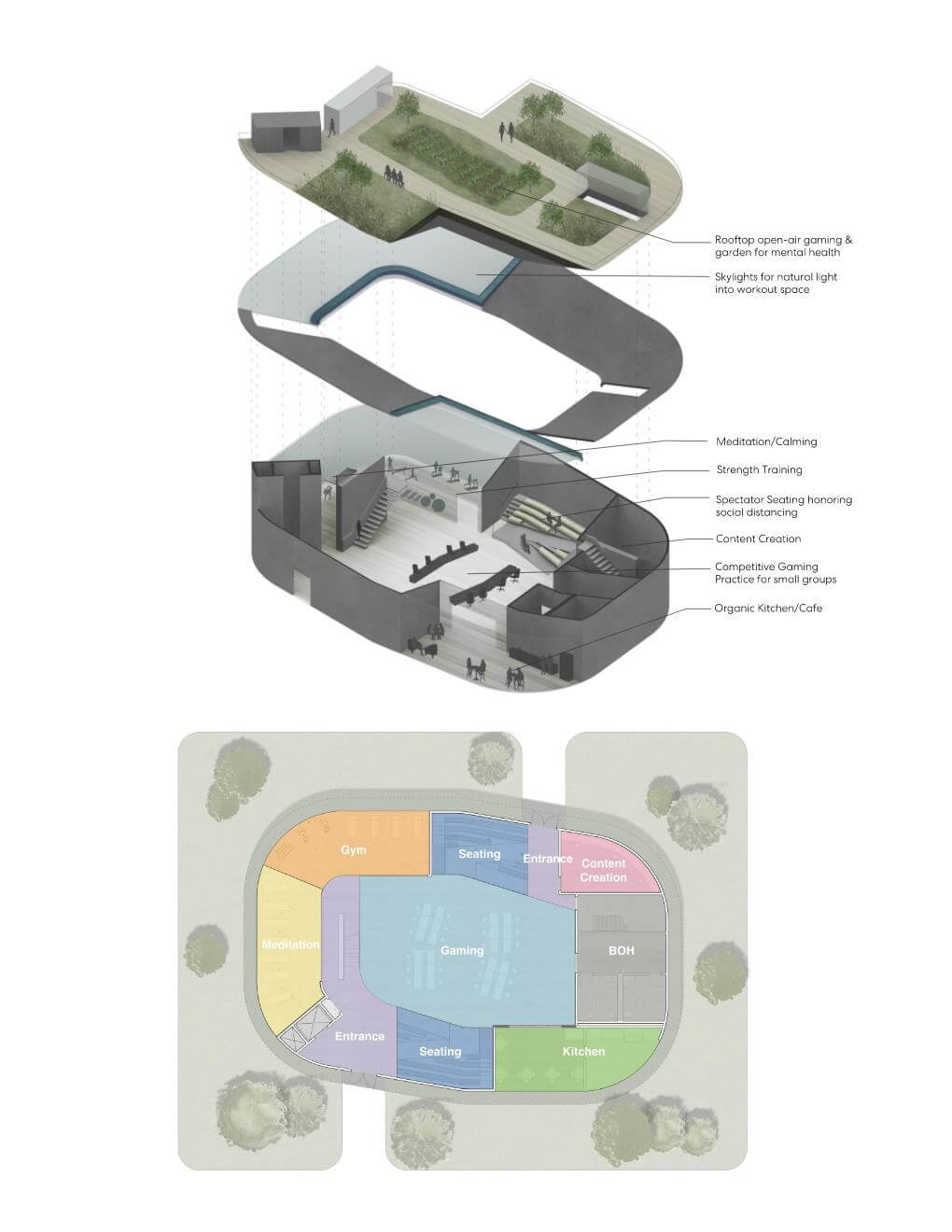
Esports “Ecosystems” with Flexible Learning Hubs
As Jim O’Hagan, founder of the popular podcast The Academy of Esports and Director of Visual & Digital Learning for Racine Unified School District, explains it: Esports can open college and career pathways, because it exposes students to a wide range of areas, from film production to computer programming to animation. Jim was the first to develop the concept of a “Scholar Gamer” in the K-12 realm—that is, the gamer who also performs activities in the gaming ecosystem, from shoutcasting, coaching, managing social media, organizing tournaments, and doing data analysis.
Based on this concept, consider implementing an “ecosystem” surrounding the gaming lab or a network of interconnected spaces. These hybrid learning hubs could go beyond gaming to help support students’ mental health, physical well-being, nutrition, and related academic programs. This diagram illustrates how a flexible learning hub could support the scholar gamer to provide a richer learning experience.
Café for Health/Nutrition
Scott Schroeder, the Director of Visualization in our Denver studio, and an esports expert, shared that professional gamers typically work with nutritionists and have strict wellness regimens. For example, leading esports organization Team Liquid is building a state-of-the-art, 8,000-square-foot training facility in Santa Monica, providing athletes with their own full kitchen, a personal chef, and personalized meals.
While this is an extreme example, the reasoning is sound: Cognition, focus, reaction times, reflexes, and the ability to make fast decisions—all integral to gaming performance—are linked to proper nutrition. To help optimize mental performance, a small kitchen space near the gaming lab could be useful for providing nutritious foods to players.
Calming/Meditation Room for Player Well-being
Mental health issues such as depression and anxiety can begin to manifest at a young age. Consistent physical activity has been proven to improve mental health and overcome the associated symptoms that may affect an individual’s ability to perform. Dedicated amateur and professional gamers spend countless hours inside and away from sunlight, which deprives them of vitamin D and which can increase the likelihood of depression. “Players’ heartrates can reach up to 180 bps during competitions, and they produce the same amount of the stress hormone cortisol as a race car driver,” says Scott.
Designing a Calming Room or meditative space near the gaming lab is recommended to help mental health. This can be a small, safe space with soft seating and soothing lighting for personal reflection to prevent player stress and burnout.
Workout Space for Strength Training
Exercise, physical activity, a wellness regimen, and strength training have countless benefits for esports gamers. Research links these to improved brain cognitive activity, increased blood flow, faster brain processing speed, improved memory, improved reaction times, and decreased anxiety and depression. Additionally, many esports players battle carpel tunnel syndrome, and training can improve grip strength and dexterity. While strength training sounds outlandish for younger players, many predict it will be commonplace in five to 10 years.
If space allows, incorporate a small workout area with strength training equipment, hand weights, yoga mats, and cardio machines such as treadmills with plenty of fenestration, natural light, and views to nature.
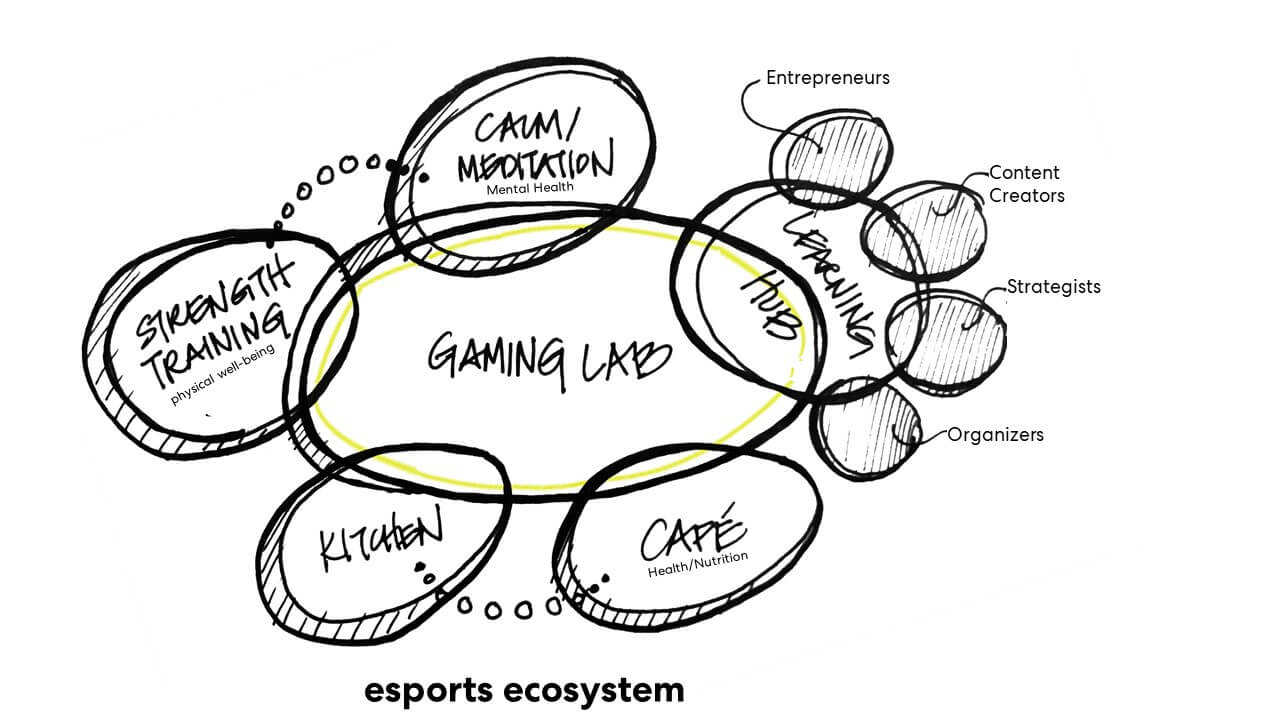
COVID considerations
While the possibilities for building ideal esports environments are plentiful, the current moment dictates that we follow CDC guidelines to ensure student safety. Building on our K-12 Road Map for Return, we recommend measures such as temperature checks at venue entrances and mandatory mask wearing at all times. The room might be reconfigured to increase social distancing, as suggested above—and overall venue capacity should be reduced by one third or more. Finally, a focus on high-touch surfaces is paramount. Stations and equipment should be cleaned between use, and where possible, students should bring their own headset, mouse, and keypad.
The benefits of esports to students are clear: They are inclusive, increase opportunities for participation, promote physical and mental health, and open up collegiate scholarship pathways. We may not know exactly what the world will look like when students fully return to school, but we can be prepared to adapt to provide them with the facilities to help them flourish.
